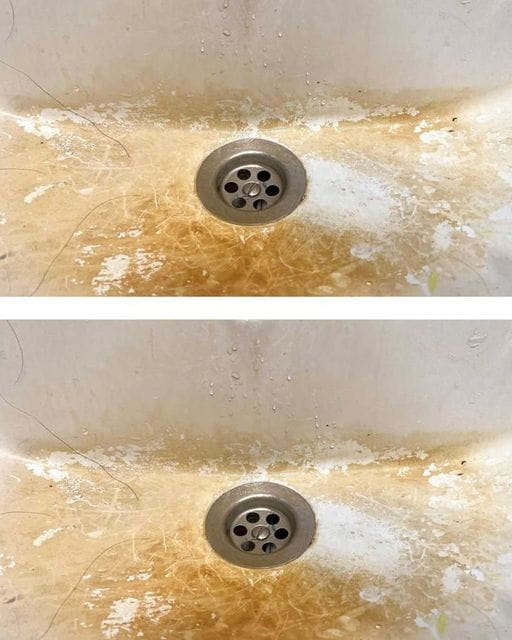When I first became a landlord, I envisioned countless satisfied tenants, beautiful properties, and smooth transactions. However, reality can often take a different turn. Recently, when my latest tenant vacated, I discovered a kitchen sink that told a story of neglect, one that was riddled with lime scale and rust. The sight was daunting, and I quickly realized that I had a formidable task at hand. If you’re facing a similar situation, don’t fret! In this article, we’ll explore effective methods for removing lime scale and rust from a sink, ensuring your space dazzles once again.
Understanding the Culprits: Lime Scale and Rust
Before diving into the solutions, it’s essential to grasp what we’re dealing with. Lime scale forms due to the hard water that contains high concentrations of calcium and magnesium. Over time, as the water evaporates, these minerals settle on surfaces, leading to that unsightly white, chalky residue.
Rust, on the other hand, is the result of iron oxidizing—basically, metal reacting with moisture in the air. In older sinks, particularly those made of iron or steel, rust can be a common nuisance. It’s important to remember: both these issues not only tarnish the aesthetic appeal of your sink but can also lead to long-term damage if left untreated.
Assessing the Damage
Before setting out to combat these stains, it’s crucial to assess the degree of damage to the sink. If the rust and lime scale are superficial, you might have an easier time cleaning them up. However, if they’ve penetrated deep into the material, you may need to consider more drastic measures, such as replacement or professional intervention.
Once you’ve assessed the damage, you can identify the right cleaning approach based on the sink’s material (stainless steel, porcelain, cast iron, etc.). Here’s how to treat each type.
Cleaning Stainless Steel Sinks
Stainless steel sinks are ubiquitous in modern kitchens thanks to their durability and aesthetic appeal. However, they are not immune to lime scale and rust, especially if they haven’t been cleaned regularly.
Lime Scale Removal
- Vinegar Method:
- Pour white vinegar into a spray bottle and generously coat the affected areas. Let it sit for about ten minutes.
- Scrub gently with a soft sponge or cloth. Rinse thoroughly with warm water and dry with a microfiber cloth.
- Baking Soda Paste:
- Create a paste by mixing baking soda with water. Apply it on the lime scale spots and let it sit for about 20 minutes.
- Using a soft brush or sponge, scrub to lift the residue and rinse afterward.
Rust Removal
- Cream of Tartar:
- Mix cream of tartar with a bit of water to create a paste. Apply it to the rusted areas and let it sit for about 30 minutes.
- Rinse off with warm water and dry.
- Commercial Rust Removers:
- For more severe rust, consider a commercial rust remover designed for stainless steel sinks. Follow the manufacturer’s instructions closely to avoid damaging the surface.
Cleaning Porcelain Sinks
Porcelain sinks are notorious for their beautiful finish and, unfortunately, their susceptibility to both lime scale and rust.
Lime Scale Removal
- Baking Soda and Vinegar:
- Sprinkle baking soda over the affected areas, then spray or pour vinegar on top. The chemical reaction will help lift the scale.
- Allow it to fizz for about 15 minutes, scrub gently, and rinse with warm water.
- Citric Acid:
- Dissolve citric acid in water and apply it to the spots with lime scale. Let it sit for approximately 20 minutes, then scrub and rinse.
Rust Removal
- Lemon Juice and Baking Soda:
- Create a paste using lemon juice and baking soda. Apply it to the rusted area and let it soak in for about 30 minutes.
- Scrub carefully with a sponge and rinse thoroughly.
- Oxalic Acid:
- For persistent rust stains, a diluted solution of oxalic acid may be used. Apply carefully (wear gloves!), scrub, then rinse well. Be cautious: oxalic acid can be harmful, so use it as a last resort.
Cleaning Cast Iron Sinks
Cast iron sinks can be a bit trickier to clean because they may have a porcelain enamel coating, which is susceptible to scratching.
Lime Scale Removal
- Vinegar and Baking Soda:
- Follow the same baking soda and vinegar method as with porcelain sinks, but be gentle to protect the enamel.
- Soft-Bristle Brush:
- Use a soft-bristle brush to scrub lime scale—avoiding wire brushes that can damage the enamel.
Rust Removal
- Baking Soda Paste:
- Mix baking soda with a small amount of water to create a paste. Apply it to rusted areas and let it sit for about 30 minutes.
- Scrub gently and rinse thoroughly.
- Rust Remover Solutions:
- Consider commercial rust removers made for cast iron, ensuring they are safe for use on enamels.
Preventing Future Accumulation of Lime Scale and Rust
Once you’ve successfully cleaned your sink, it’s crucial to put preventive measures in place to avoid the disheartening return of lime scale and rust.
- Routine Cleaning:
- Adopt a regular cleaning routine using mild cleansers. Wipe down your sink after use to reduce mineral deposits.
- Water Softening Systems:
- If your area has particularly hard water, consider investing in a water softener to reduce lime scale formation at the source.
- Sealing:
- Some sinks benefit from sealants designed specifically for enhancing the surface protection against mineral buildup. Research if this is a suitable option for your sink type.
- Fix Leaks:
- Address plumbing leaks swiftly. Continuous moisture contributes significantly to rust formation and mineral buildup.
Final Thoughts: Making Your Sink Shine Again
Dealing with lime scale and rust might seem overwhelming, particularly when you’re trying to maintain or prepare a rental property. However, with the right methods and preventive measures more resilient than ever, your sink can be restored to its glorious shine. Not only does it improve aesthetics, but it also ensures the longevity of your fixtures—something any good landlord or homeowner desires.
Remember, every property tells a story, and it’s up to you to ensure that the next chapter is bright and beautiful. Before rolling up your sleeves, gather your supplies, put on your favorite playlist, and prepare to breathe new life into that sink!




